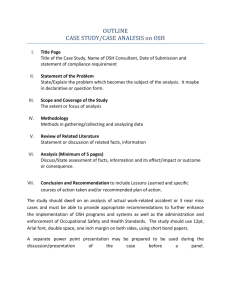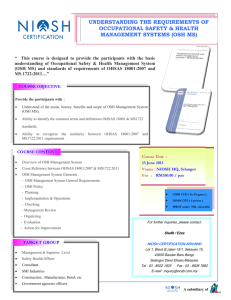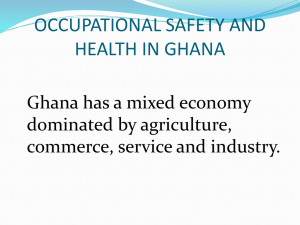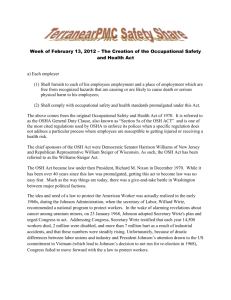riview of literature ARM
advertisement
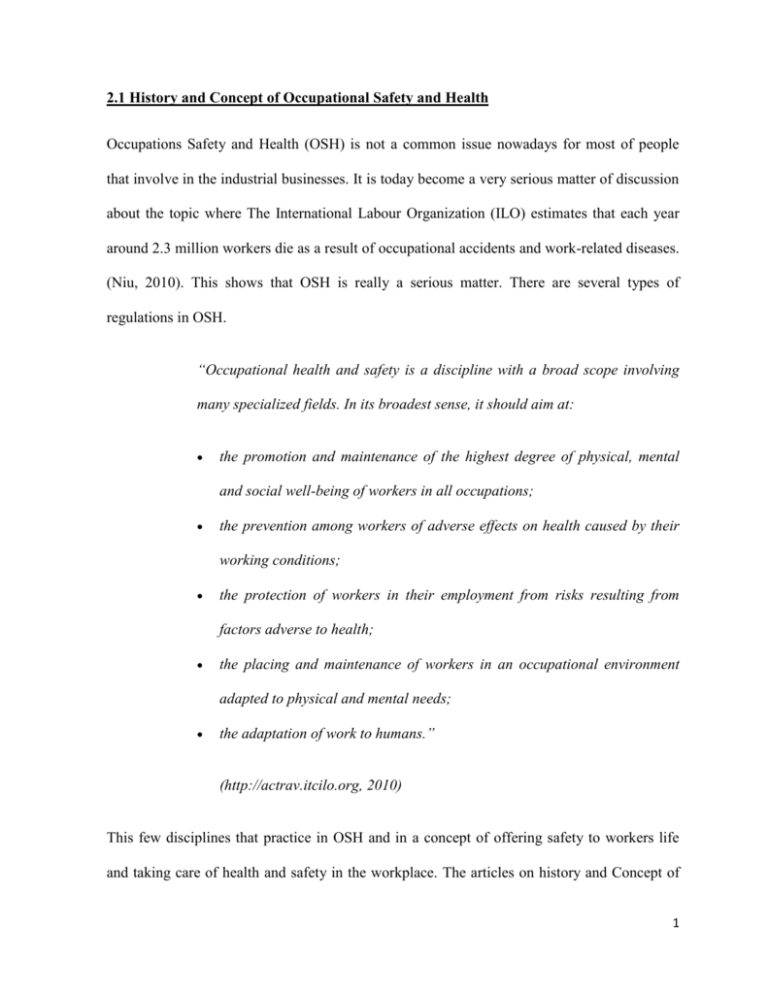
2.1 History and Concept of Occupational Safety and Health Occupations Safety and Health (OSH) is not a common issue nowadays for most of people that involve in the industrial businesses. It is today become a very serious matter of discussion about the topic where The International Labour Organization (ILO) estimates that each year around 2.3 million workers die as a result of occupational accidents and work-related diseases. (Niu, 2010). This shows that OSH is really a serious matter. There are several types of regulations in OSH. “Occupational health and safety is a discipline with a broad scope involving many specialized fields. In its broadest sense, it should aim at: the promotion and maintenance of the highest degree of physical, mental and social well-being of workers in all occupations; the prevention among workers of adverse effects on health caused by their working conditions; the protection of workers in their employment from risks resulting from factors adverse to health; the placing and maintenance of workers in an occupational environment adapted to physical and mental needs; the adaptation of work to humans.” (http://actrav.itcilo.org, 2010) This few disciplines that practice in OSH and in a concept of offering safety to workers life and taking care of health and safety in the workplace. The articles on history and Concept of 1 Occupational safety and Health (OSH) suggest that it can be discussed in two different perspectives. The first concept and theory in history of OSH used is the old concept and then the new era concept of OSH which have the similarities and differences. The old concept of OSH history suggests that OSH was began just after the establishment ILO which after Second World War and functions as an organization in putting all workers either male, female, children or adult in safe hand. (Holmesa, Giffordb, & Triggs, 1998). According to Stellman, in her book Encyclopedia of Safety and Health noted that the concept of OSH after Second World War was not very general and indeed lack of supervision. She suggested that the concern about safety in the workplace was not so much and the system used during that time still have not been organized completely. The lack of supervision leading towards unpredictable accident occurs (stellmen, J. M. 1998) which bring into fatal cases. Greenberg. L, in his article asserts that old concept of OSH have a lot of weaknesses. One of the weakness listed is the regulations and supervision in providing enough guidelines to the employee of a company in ensuring the safety in the workplace. ILO is one of the international organization that fuctioned to standardized all safety regulations in workplace, running campaign for the awareness, delivering projects for inspection, analyzing databases and statistics, and preparing training to any companies that needed. (www.ilo.org, 2010). The very first concept of OSH does not have a clear aim and objectives, however only few years after the ILO was introduced, it became more practical. Most of the employer during second world war era have not being guide by rules and regulations of safety and health in their workplace. 2 Few years after ILO were established, new concept of OSH started in the early 1970’s. The are many additions in the regulations of safety guidelines. Ergonomics, a term that first surfaced in the 1940s, is the science of adapting work and working conditions to the physical needs of the workers rather than requiring the worker to adapt to the inadequately designed working environment. (Niu, 2010) “World War II marked the development of new and complex machines and weaponry and these made new demands on operators' cognition. The decisionmaking, attention, situational awareness and hand-eye coordination of the machine's operator became key in the success or failure of a task. It was observed that fully functional aircraft, flown by the best-trained pilots, still crashed. In 1943, Alphonse Chapanis, a lieutenant in the U.S. Army, showed that this so-called "pilot error" could be greatly reduced when more logical and differentiable controls replaced confusing designs in airplane cockpits. In the decades since the war, ergonomics has continued to flourish and diversify. The Space Age created new human factors issues such as weightlessness and extreme g-forces. How far could environments in space be tolerated, and what effects would they have on the mind and body? The dawn of the Information Age has resulted in the new ergonomics field of human-computer interaction (HCI). Likewise, the growing demand for and competition among consumer goods and electronics has resulted in more companies including human factors in product design.” (http://en.wikipedia.org/wiki/Ergonomic,2010) 3 According to Niu in his article, the new concept of OSH introduced with a definition of occupational health with the Joint of ILO/WHO Committee at its first session (1950) and revised at its 12th session (1995) which had stated the aim of the OSH: 1. the promotion and maintenance of the highest degree of physical, mental and social well-being of workers in all occupations 2. The prevention amongst workers of departures from health caused by their working conditions 3. the protection of workers in their employment from risks resulting from factors adverse to health; the placing and maintenance of workers in an occupational environment adapted to their physiological and psychological capabilities; and, to summarize, the adaptation of work to the workers and of each worker to his or her job. From the aim listed, it were clearly stated that new concept of OSH has a clear objectives in caring and protecting the worker from any accident that might be happen to them in the workplace. This Concept had been practiced until today and the regulations have been renewed and lots of addition because of the advancement of technology used in the industry. In the 21st century, OSH management system was developed into a computer program. Greenberg. L (1982) stated that this module is intended to assist the practitioner with the preparation, management, and planning of the safety program. Towards this end, the safety sampling program allows one to prepare a plan for sampling safety behavior or performing air monitoring at random times. Therefore, the management of safety and health in workplace become easier and faster. 4 In a nutshell, OSH has two concept according to historical timeline which are the old concept which lack of regulations and not very practical and the new concept which is eligible in this era. Both of the concepts still do have similarities which is the concern about the safety and health of employee in the workplace to be ensured. In the same time, both concepts have a big difference to each other where the problems and weaknesses in the old concept were revised again and renewed to ensure the system is up to date. This is to ensure that the employees of this era were treated more carefully and in justice. The system of safety and health in workplace should be taken more seriously by government and employer because the matter of safety and health is not a small thing and it can cause big impact to one’s employee. Technology should be taken in to ensure the system of OSH in any company is more strategic. 5 Bibliography. (2010, Jan). Retrieved August 9, 2010, from Labor Education Program: http://actrav.itcilo.org Ergonomics. (2008, August 21). Retrieved August 9, 2010, from Wikipedia: http://en.wikipedia.org/wiki/Ergonomic Greenberg, L. (1982). The practice of occupational safety and health—facing the twenty-first. American Industrial Hygiene Association Journal , 666 — 673. Holmesa, N., Giffordb, S. M., & Triggs, T. J. (1998). Meanings of risk control in occupational health and safety among employers and employees. Safety Science , 141-154. Introduction to Occupational Safety and Health. (2008, october). Retrieved August 9 , 2010, from International Labor Organization: www.ilo.org J.M, S. (1998). Encyclopedia of Occupational Safety and Health. New York. Koradecka, D., & Dryzek, H. (2001). Occupational Safety and health in Poland. Journal of Safety Research , 187– 208. Niu, S. (2010). Ergonomics and occupational safety and health: An ILO perspectiv. Applied Ergonomics , 744e753. Zwi, A., fonn, S., & Steinberg, M. (2002). Occupational health and safety in South Africa: The perspectives of capital, state and unions. Safety Sciences , 691-702. 6
